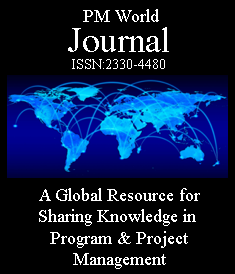ADVISORY
By Dr. Kenneth Smith, PMP
Honolulu, Hawaii
& Manila, The Philippines
“Find out the cause of this effect,
Or rather say, the cause of this defect,
For this effect defective comes, by cause.”
Polonius, in Shakespeare’s Hamlet
Despite an abundance of practical project management knowledge, tools & techniques disseminated over decades by the Project Management Institute (PMI) and other organizations, project implementation continues to break all bounds of the “Cost, Quality, Time” management triangle; busting budgets and delivering poor products while slipping schedules. However, one does not need to forage far or dig deeply to discover the root cause. People! Willful attitudes, myopic perceptions & misusing extant tools with problematic procedures are the culprits; not the tools per se. It is high time to refocus attention on these flaws, for correction or mitigation.
My article last month[1] spotlighted several black elephants[2] skulking in the triangle’s ‘time’ span that people tend to ignore. This month I’m highlighting a white elephant[3] leading the ponderous pachyderm procedural parade that some people proudly proclaim; blatantly trumpeting ‘Cost Containment’ uber alles, while concurrently trampling on program & project Qualities.

Far from being efficacious, the ‘lowest-cost’ procurement process is a ‘Worst Practice’!
Although seemingly praiseworthy from a buyer’s financial standpoint, and acclaimed by many more adherents of the practice – due to ‘Strategic Misrepresentation’ [4] — the unitary “Lowest Cost” criterion for project selection is actually very destructive. ‘Cost over Quality’ does immediate disservice to both the procuring organization and its would-be contractors; subsequently to the contract awardee, and ultimately to the project’s eventual users.
Although a few organizations conceive, plan & execute their projects entirely ‘in-house’ through owner-funding, operation and management in attempts to minimize costs, most organizations call on external contractors to undertake their projects, in all or part. In that regard it is important to recognize contracts are the life-blood of contractors! This near-tautological truism needs reemphasizing for governments, corporations, institutions, and other entities who procure products or desire contractual services and utilize the “Lowest Cost” approach for awarding contracts. Contractors are not simply in the business of breaking even while servicing others; they require reasonable profit from their endeavors for their own sustenance, and growth.
However, the Lowest-Cost procurement process negates the effort by both parties that went into establishing the scope & criteria, and preparing proposals to meet them. Project Bids & Awards Committee (PBAC) technical panel assessment activities to determine bid merits are subsequently rendered futile. Penny-pinching practices & penurious awards also instigate ‘vicious project sub-cycles.’ Rather than encouraging would-be contractors to submit proposals for projects that could excel; lowest-cost awards incentivize bidders to be short-sighted, and only base proposals on ideal assumptions.
Consequently, contingencies for risks are cut, and only low-quality products & technical services are proposed to merely meet buyer’s minimal requirements. Proposal sojourns in the project’s ‘promised land’ thus lack a ‘Plan B’ to mitigate inevitable issues. Happiness for the successful bidder is short-lived however when things don’t go according to plan. The end result is schedule slippages, as well as self-induced costly overruns; and target beneficiaries disappointed with low-quality products as well as project results far from what was promised.
More…
To read entire article, click here
How to cite this article: Smith, K. F. (2025). Project Proposal Processing & ‘Lowest-Cost’ Lunacy, PM World Journal, Vol. XIV, Issue III, March. Available online at http://pmworldlibrary.net/wp-content/uploads/2025/03/pmwj150-Mar2025-Smith-project-proposal-processing-low-cost-lunacy.pdf
About the Author

Dr. Kenneth Smith
Honolulu, Hawaii
& Manila, The Philippines
![]()
Initially a US Civil Service Management Intern, then a management analyst & systems specialist with the US Defense Department, Ken subsequently had a career as a senior foreign service officer — management & evaluation specialist, project manager, and in-house facilitator/trainer — with the US Agency for International Development (USAID). Ken assisted host country governments in many countries to plan, monitor and evaluate projects in various technical sectors; working ‘hands-on’ with their officers as well as other USAID personnel, contractors and NGOs. Intermittently, he was also a team leader &/or team member to conduct project, program & and country-level portfolio analyses and evaluations.
Concurrently, Ken had an active dual career as Air Force ready-reservist in Asia (Japan, Korea, Vietnam, Indonesia, Philippines) as well as the Washington D.C. area; was Chairman of a Congressional Services Academy Advisory Board (SAAB); and had additional duties as an Air Force Academy Liaison Officer. He retired as a ‘bird’ colonel.
After retirement from USAID, Ken was a project management consultant for ADB, the World Bank, UNDP and USAID.
He earned his DPA (Doctor of Public Administration) from the George Mason University (GMU) in Virginia, his MS from Massachusetts Institute of Technology (MIT Systems Analysis Fellow, Center for Advanced Engineering Study), and BA & MA degrees in Government & International Relations from the University of Connecticut (UCONN). A long-time member of the Project Management Institute (PMI) and IPMA-USA, Ken is a Certified Project Management Professional (PMP®) and a member of the PMI®-Honolulu and Philippines Chapters.
Ken has two KENBOOKS: 1. Project Management PRAXIS which includes many innovative project management tools & techniques; and describes a “Toolkit” of related templates, and 2. MUSINGS on Project Management — a compilation of contemporary concerns in project planning, monitoring & evaluation, with some tools & techniques suggested for their solution. Either or both books are available from Amazon, and their related templates are available directly from him at kenfsmith@aol.com on proof of purchase.
To view other works by Ken Smith, visit his author showcase in the PM World Library at https://pmworldlibrary.net/authors/dr-kenneth-smith/
[1] Smith, K. F. (2025). Slipped Schedules, Touch-Time, and Black Elephants! Advisory article, PM World Journal, Vol. XIV, Issue II, February
[2] While neither physical nor black, in the project management vernacular a ‘black elephant’ is an idiom for adverse readily-apparent phenomena to which the project’s management is either oblivious, is tolerating, or ignoring.
[3] A white elephant is an object (or procedure) which is retained and supported, despite the excessive cost &/or effort required for its operation & upkeep
[4] Exaggerating benefits, minimizing &/or ignoring risks, while knowingly understating costs, or turning a blind eye to them; as per Bent Flyvbjerg & Dan Gardner, (2023) “How Big Things Get Done.” Crown Currency, New York









